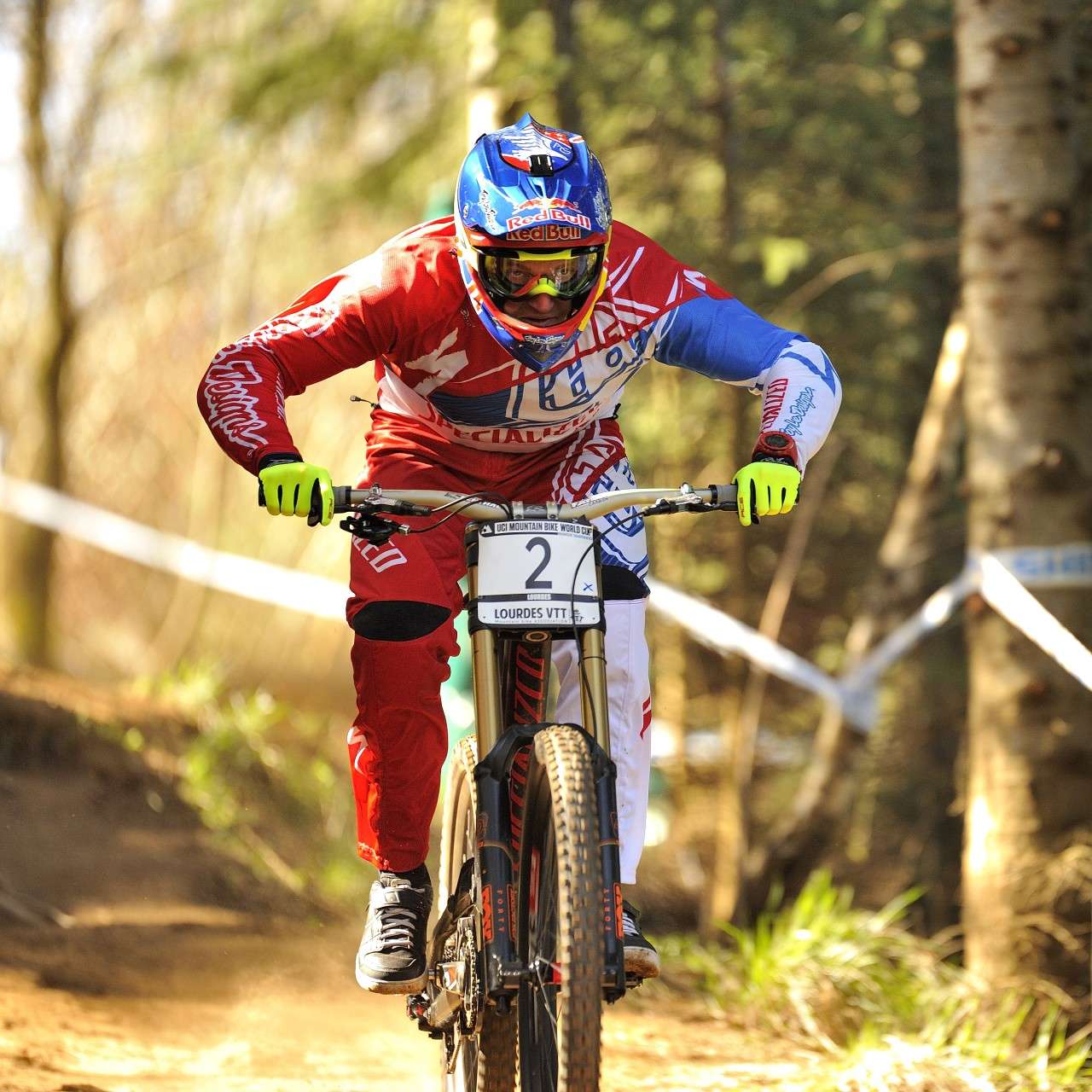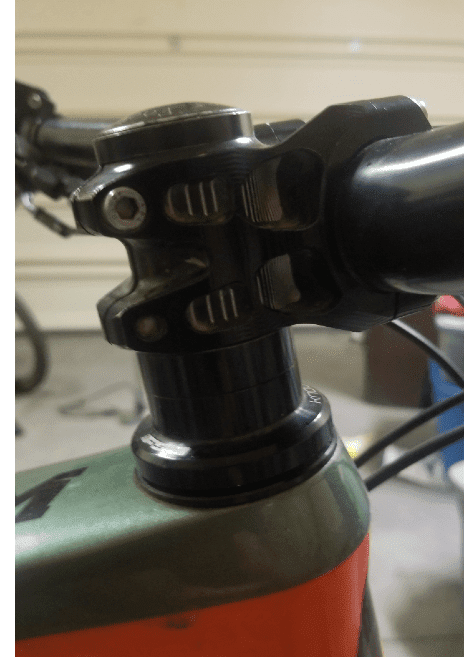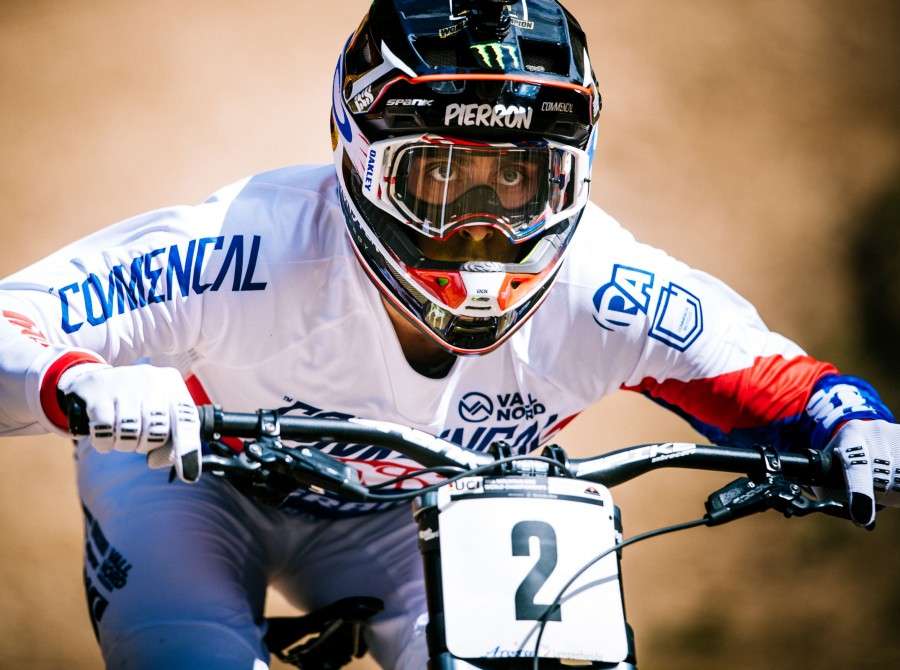Iwould like to share an IMPORTANT BIKE SETUP CONCEPT with you that greatly impacts how you ride. I’ve been experimenting with this for years but since writing this article two years ago, I have been really paying attention to my bar height.
As I go from bike to bike (everyday bike, downhill bike, ebike) I have found that even a 5mm difference in height affects my body position (all three bikes have very similar geometry, the same length stem, the same handlebars, the same grips, and the same handlebar roll).
This article assumes you already know what width bar you like, what bar roll you like, what lever placement you like, and what grips you like. It has to assume those things as I was taught never to make more than one change at a time. If you make two changes at once (change your bar height and bar width at the same time) you won’t know what caused it to feel better or worse after the changes. I am working on a “cockpit subtleties article” that covers handlebar roll and lever placement
Precise handlebar height is more important than I realized! I made a small handlebar height adjustment and it ended up sabotaging my racing and riding for 6 weeks. Many of my students’ handlebars are too high and often we lower them 10-50mm, to get them in a better, more confident position.
Often, bikes come from the shop in the most comfortable position with 20-50mm of spacers under the stem and riser bars (bars that rise 15 to 40mm higher than the stem). This feels good in the parking lot and while seated and pedaling on mellow terrain, but when you want to ride more demanding trails, it can get in the way.
In my courses, I explain that if your bars are too high it makes riding more difficult. When climbing with your handlebars too high, it is hard to hinge forward enough to keep the front wheel on the ground on steep climbs, even when you have slid your weight all the way forward on the saddle.
With high handlebars, wheelies and manuals are harder to do and tend to put you in a “hanging off the handlebars” body position with your weight too far back while descending.
The GOAL of finding the right handlebar height is to find a height that puts you in an athletic, centered, neutral, and hinged body position when standing and descending while not compromising your climbing body position.

Aaron Gwin in a hinged-at-the-hips-flat-back riding position. (Photo by Downhill911)
Reaching this goal has become a challenge as our wheels get bigger and forks get taller with more suspension travel. For people approximately 5’6” and shorter, it was much easier to get the bar height right on a 26” wheeled bike with 75mm of suspension travel than a 29er with 130-170mm of travel.
Before we get further with bar height, LET ME EXPLAIN AN IMPORTANT RIDING CONCEPT:
Riding confidently and on the offense (riding with a focus on accomplishing what you WANT to do instead of focusing on what you DON’T WANT to do) is one of the most important aspects of mountain biking.
Focusing on getting to the bottom of the descent smoothly or quickly instead of focusing on not crashing, is paramount to riding at your best.
It turns out that HANDLE HEIGHT affects more than just your body position! A mere 16mm rise in bar height (that I thought was going to take the stress off my shoulders and allow me to look further ahead) not only hurt my position (as I teach) but it killed my confidence.
-
-
- That 16mm rise put me in the “hanging off the back of your bike” position. In my courses, I teach that too-high handlebars make it harder to stay centered while descending.
- If you think about it, that is a very defensive posture; leaning back away from danger.
- It is also more upright than being hinged forward at the hips with a flat back. Being upright decreases our stability and our ability to stay neutral(where we can react/respond better to what the trail throws at us).
-
Check out my “Body position and Fundamental Movement Video Tutorial”
Well, that defensive posture put me on the defensive and 3 years ago I spent the week of the National Championships riding scared (I managed to win but was disappointed in my nervous riding). Let me tell you this is a vicious cycle!
Start riding on the defensive and you start making mistakes. Those mistakes scare you so you feel like you can’t ride well – further shaking your confidence.
Of course, I attributed this to a crash I had three weeks before, not to the seemingly insignificant change in bar height. This did feel a little weird right away, but change always feels weird so I just thought I would get used to it.
After racing the National Championships and then another regional race, I was really frustrated with how I was riding.
BUT THEN I realized my handlebar height might be the culprit so I lowered the bars 10mm by removing two headset spacers under the stem. (My handlebars in the photo below with spacers below the stem).

The difference in confidence was immediate! With the first run with lower bars, I was riding much more aggressively.
Until this experiment, it would have been hard for me to believe 10mm in bar height could make that much of a difference but, it did! It forced me to hinge a little more and more importantly, it centered me over the bike in a much more stable and aggressive position.
I often tell students that their handlebars are too high when they are obviously 20-60mm too high, but now I know to stress experimenting with bar height more for all my students. If 10mm can make a huge difference in body position, confidence and control imagine what 15-60mm could do.
All of that contributes to putting us in an upright and slightly back-of-center position: not quite in balance, not neutral, and ultimately a defensive position.
IN SHORT – experiment with your handlebar height. Go as low as you can go with your current bars. Many riders (those under 5’10 riding 29ers and under 5’8″ on 27.5 bikes) should try a bar with no rise.
Your handlebar height should help you achieve the hinged-at-the-hips-flat-back riding position like Amaury Pierron pictured below.

Amaury Pierron hinged-at-the-hips-flat-back riding position
I wish there was a simple formula for bar height. For me, it is when my bars are about 3″ above my knee when standing and coasting with pedals level.
For shorter people, it can be as high as their belly button when they are standing on the pedals. I have been searching for that formula for years but there are just too many variables, 3 people of the exact same height are likely to have different limb lengths, shoulder widths, differing amounts of core strength and hip mobility, etc and be on bikes with different headtube heights and frame reach measurements.
One of my coaches taught me that, instead of looking for a formula, you should be focusing on whether you are in an athletic position. If you are not in an athletic position, stop and make adjustments to get yourself in that position.
Again, the GOAL is to have your bars low enough for climbing and to put you in an athletic, hinged-at-the-hips position when standing and descending.
- Too low and it may hurt your back and make it hard to look ahead.
- Too high and you may struggle with keeping your front wheel on the ground during steep climbs and/or find yourself hanging off the back of your bike while descending.
The old rule of thumb that your handlebars should be level with your saddle (at full climbing height) to 3 inches below your saddle (at full climbing height) is a great place to start.
In general, the taller you are the more drop-from-saddle-height-to-bar-height you will have.
At 6’3” my bars are about 2.5” lower than my saddle. Many riders who are under 5’6” will find it hard to even get the handlebars level with the saddle on a 29r. Pro XC racer, Chloe Woodruff who at 5’2”, runs a negative rise stem to get her bars lower (as do many riders under 5’6”, especially if they ride 29er’s).
Many/most mountain bikes are sold with handlebars as high as the steerer tube will allow. This is usually the most comfortable position for seated riding (allows a straighter back, and less hinging at the hips) and it leaves four or five 5mm spacers under the stem. This gives you 20-25mm of adjustment.
Often, I suggest a student remove all the spacers from below their stem and put them on top (lowering their bars 20-50mm) and they love it.
All of my bike setup suggestions are based on performance, not comfort! Comfort is important though – if your bike isn’t comfortable you are less likely to want to ride it. If you find lowering your handlebars to be uncomfortable, give it 4-5 rides to see if your body adapts. You may be forced to choose between comfort and performance (or work on your core strength and mobility).
Lower bars will always help in climbing too, as it is easier to keep enough weight over the front wheel. With today’s taller bikes most of us could benefit from lowering our bars. All of us could benefit from experimenting with bar height!
Go out and experiment. Take your time; change feels weird so weird isn’t necessarily bad.
Please share this article with anyone you think may benefit and feel free to call or e-mail with any questions.
Thanks and create your best ride yet,
Gene





Very nice article Gene, well done. I am going to have to wait for the zero degree wind chill to pass before I can try it. Thanksgiving week is looking good. Hope you have a good one.
Ray
On point here. I had bars tooth a rise on them at 745mm wide. Couldn’t corner. Went with a low rise bar at 715mm. My body position is more centered and my hinge is lower, putting more pressure under the front tire. Haven’t washed our since!
I am one of the obsessives who actually has done a lot of experimenting with bar height, which is an annoying task, what with all the levers needing readjustment each time. I am 5’8″ but have short arms and legs. I use fairly high riser bars (40 and 60mm) on my bikes. Not too long ago I actually tried flat, 20mm, 40mm and 60mm risers on the same bike, giving each one a good run on local singletrack.
What I noticed was that the smaller the rise, the more inhibited I felt in leaning the bike down on tight or fast turns. I felt like a short armed trombonist When I ran out of arm, with the smaller rise bars, I didn’t feel sufficiently leaned, but any more lean would cause my body to start moving down to the inside of the turn. I didn’t like that much.
I didn’t notice an effect on my hinging, but I admit I didn’t look for it. I am still so weak with front wheel stuff, I am not sure if it would be a big factor. I may not be at my sweet spot yet.
Gene,
Many of your students prioritize riding longevity which is all about minimal impact on the aging body. You will be joining us over the next decade, bud.
So I always smile when I read your latest on bar height. I think, respectfully, you are overlooking the bigger picture of the bigger race: who is still riding at 50, 60, 70, 80, 90, 100, and beyond.
If you showed your pix of race riders to PT’s and ortho docs they would be alarmed at the neck angles. Is the “C6-C7 spinal motion segment” being “sabotaged” (to use your term) by race practices and recommendations?
I’ve noticed good yoga instructors are very cautious in that zone of neck angle. The human neck is not supposed to be there for very long, especially with impacts. Damage is accumulating in some riders and unfortunately will cause problems a few years down the road.
It was for me. Three years ago I RAISED my bars a couple inches using a stem raiser. It was fantastic.
My C6-C7 discomfort from a low bar and excessive neck angle went away and after some adjustment I ride longer, stronger, under better control, with less damage to the body. What a revelation. It made me sing the “circus song” again.
Speed is great for some folks at some stages of life and risks must be taken.
But it would be good if you could always include a paragraph giving a bit of context and a caveat that different riders are different, with different priorities and needs which change over time.
Thanks, John
Hi John,
I pretty much agree with everything you said. I did include a paragraph about how this setup is for optimum performance but comfort is very important too. “All of my bike setup suggestions are based on performance, not comfort! Comfort is important though – if your bike isn’t comfortable you are less likely to want to ride it. If you find lowering your handlebars to be uncomfortable, give it 4-5 rides to see if your body adapts. You may be forced to choose between comfort and performance (or work on your core strength and mobility).” I’m still more concerned about performance and realize the price I pay is having to keep my core extremely stable and do nearly an hour of stretching after every hard ride.
Cheers,
Gene
when you use spacers to set your grips(/handlebar) higher, you’re not only moving the handlebar up, but also backwards.
the slacker your head angle the more they move back.
this also pushes your body back.
https://enduro-mtb.com/en/the-right-mtb-handlebar-rise/
often the height isn’t as much of a problem, but it’s more that people have used so much spacers that they have reduced their reach by a full frame size.
Thanks for sharing this Michael. I knew that the bars moved back as you increased the number of spacers but I didn’t realize it was close to 50% of the increase in height! I’ve been experimenting with taking 20mm of spacers out and using taller bars to put the bars at the same height but further forward and I haven’t noticed much of a difference in ride feel. My effective reach did grow by 8.5mm which is not insignificant though. More testing!
Gene
Gene,
Thanks so much for sharing your wealth of knowledge and giving it in a way that is as easy to understand as possible. I especially appreciate your humble responses to those who may have differing opinions on bar height. I am 6’3” with a 33” inseam. I have an average torso length and a longer neck. I am currently 40 years young. In my twenties into my early thirties I mostly rode drop bar bikes. I starting experiencing a lot of tension between my shoulder blades and some discomfort in my lower neck. So I started riding flat bar bikes. Made a noticeable improvement in comfort. I always aimed for saddle level with bar height. In my mid to late thirties the pain discomfort returned. I tried many things and even bought a recumbent bicycle to see if I would like it. I enjoyed the recumbent but it was a totally different experience and I missed riding a traditional bike. Since then I have been trying to hike my bars as high as I can get them without destroying steering control. I still haven’t found the sweet spot. Now I am wondering if I was going about it wrong. I am going to try lowering my bars and also experimenting with bar width to see if it helps. Again I appreciate your perspective and the time and effort you have put into publishing this article. Keep up the excellent work! Take care.
Hi M. Kendell,
You’re welcome. Another thing you can try which will greatly help with neck/shoulder/back pain is foundation training (.com). The exercises in their book completely changed my life! At 50 I was about to quit mountain biking because my back pain so severe that I could only ride for about thirty minutes. I’ve been pretty much pain-free since, going on 7 years now!
Keep riding and keep experimenting! Cheers,
Gene